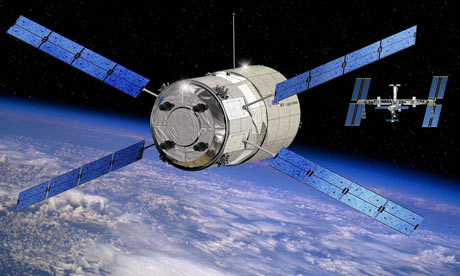
The largest, most complex spacecraft Europe has built is being readied for its maiden flight early tomorrow from the European spaceport in Kourou, French Guiana.
The 20-tonne robotic space freighter, crammed with fuel, food and spare parts is due to blast off at 4.03am GMT on a mission to deliver much-needed supplies to the international space station more than 200 miles overhead.
The automated transfer vehicle (ATV) is the first spacecraft with a built-in homing system that allows it to find its own way to the space station, without being directed from the ground or by astronauts on board the orbiting station. Once docked, it will be able to re-boost the outpost, which loses altitude over time, or lift it out of the way of dangerous space debris.
The spacecraft is so complex, the operating manual runs to 28 volumes. Named Jules Verne after the visionary French science fiction author, it is the first of many ATVs due to be launched at 18-month intervals until 2015.
Each will dock with the space station for up to six months, before being filled up with waste and jettisoned to burn up in the Earth's atmosphere.
"It's Europe's biggest spacecraft, it's by far the most complex, and it's been an amazing journey already. Now we're getting excited at seeing the fruits of our labour ready to fly," said John Ellwood, ATV project manager.
Tucked into the hold of the space freighter is an original 1900 hardback edition of Verne's science fiction novel From the Earth to the Moon, the story of three gun club members who build a giant cannon to blast themselves to the moon. The book will be kept on board the ISS and brought back by a future shuttle mission.
The launch will be an anxious moment for European space officials. The probe will be lofted into orbit by an Ariane 5 rocket, which suffered a number of dramatic failures when it was introduced in 1996.
The rocket's maiden launch ended 37 seconds into flight when a software bug caused it to explode. In 2002, another Ariane 5 veered off course and self-destructed three minutes into its journey, with the loss of two satellites.
The rocket had to be strengthened to lift the ATV, which weighs more than twice the heaviest payload an Ariane 5 has ever attempted to place in orbit
The space centre uses the faster rotation of the Earth at the equator to give launches a free boost.
Rockets launching eastwards from the site can gain an extra 1,000mph compared with launches closer to the poles.
The ATV, which is more than 10 metres long and 4.5 metres wide (33x15ft), is due to separate from the rocket's upper stage around one hour after lift-off. The craft will then unfurl solar panels and perform test manoeuvres before attempting to rendezvous with the station on April 3.
Juliet Morris, a propulsion test engineer at Astrium in Stevenage, Hertfordshire, said: "We know there have been launch failures in the past, that in a couple of seconds it can all go wrong, but I'll be most nervous when it goes for docking."
Almost six tonnes of the ATV's cargo is fuel that it will use to reach the space station and boost it to a higher orbit. A further 860kg (1896lb) of hydrazine fuel will be pumped from the ATV into the space station's own tanks. The rest of the cargo hold will carry 20kg of oxygen, 270kg of water, 136kg of spare parts for Europe's Columbus science module and half a tonne of food.
The ATV's automated docking procedure is expected to become a crucial part of future space missions, including the planned attempt to bring samples back from Mars. "If you're going to go into deep space, you need to be able to automatically rendezvous and dock if you're going to bring anything back," said Ellwood.
Strange objects
The original hardback edition of Jules Verne's De la Terre á la Lune (From the Earth to the Moon) will not be the first strange object sent to the orbiting outpost.
In 2006, thousands of fruit flies accompanied seven astronauts to the station to see if weightlessness upset their immune systems. They were joined by a container of eyelash-sized worms, courtesy of the Malaysian space agency, which was keen to see if their muscles weakened as the orbited the planet at 17,500mph. Moulds, fungi and plant seeds have also made appearances, the latter to investigate how seeds know which way is up when they are planted.
Unusual objects have also made it aboard among the personal effects each astronaut is able to carry on each mission. Also in 2006, astronaut Sunita Williams took a photograph of Gorby, her Jack Russell, alongside a miniature statue of Lord Ganesh, and a copy of the Bhagavad Gita, the Sanskrit Song of God. Last year Peggy Whitson, the first woman commander of the space station, took a kamcha, a Kazakh riding whip. The original lightsabre used by Mark Hamill as Luke Skywalker in Star Wars was taken up last year to mark the 30th anniversary of the film.
On the last shuttle flight, which delivered Europe's Columbus laboratory to the space station, the cargo included two deflated footballs, from Leland Melvin, the only former NFL footballer in Nasa's astronaut corps, who also took a copy of jazz bassist Christian McBride's Live at Tonic album. Stan Love, another astronaut on the flight, chose to take a meteorite from the University of Hawaii back into space.

